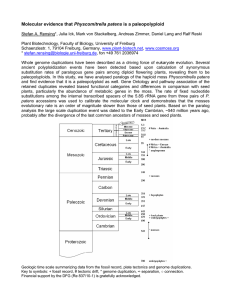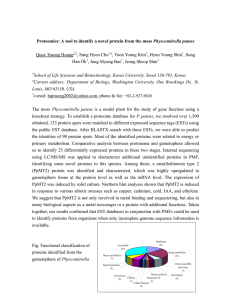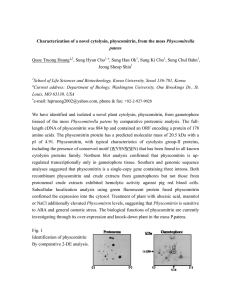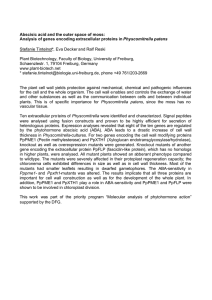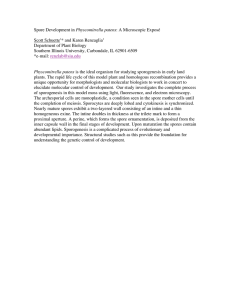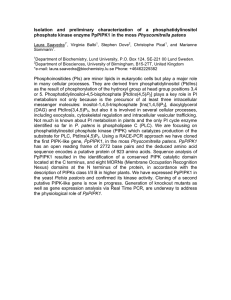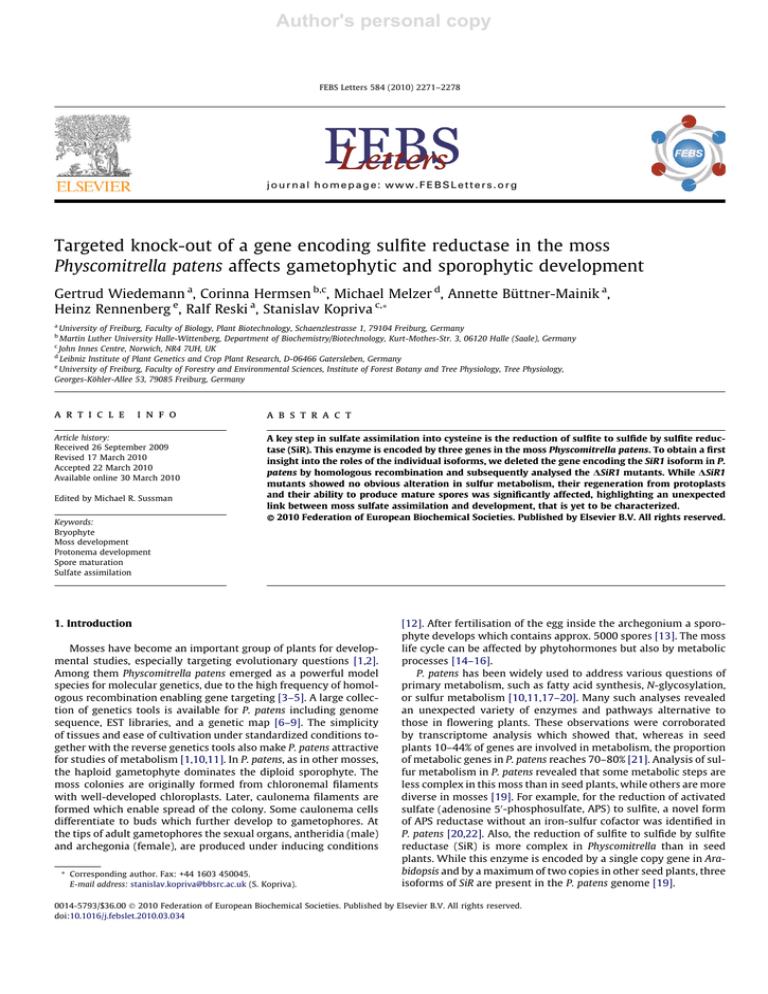
Author's personal copy
FEBS Letters 584 (2010) 2271–2278
journal homepage: www.FEBSLetters.org
Targeted knock-out of a gene encoding sulfite reductase in the moss
Physcomitrella patens affects gametophytic and sporophytic development
Gertrud Wiedemann a, Corinna Hermsen b,c, Michael Melzer d, Annette Büttner-Mainik a,
Heinz Rennenberg e, Ralf Reski a, Stanislav Kopriva c,*
a
University of Freiburg, Faculty of Biology, Plant Biotechnology, Schaenzlestrasse 1, 79104 Freiburg, Germany
Martin Luther University Halle-Wittenberg, Department of Biochemistry/Biotechnology, Kurt-Mothes-Str. 3, 06120 Halle (Saale), Germany
John Innes Centre, Norwich, NR4 7UH, UK
d
Leibniz Institute of Plant Genetics and Crop Plant Research, D-06466 Gatersleben, Germany
e
University of Freiburg, Faculty of Forestry and Environmental Sciences, Institute of Forest Botany and Tree Physiology, Tree Physiology,
Georges-Köhler-Allee 53, 79085 Freiburg, Germany
b
c
a r t i c l e
i n f o
Article history:
Received 26 September 2009
Revised 17 March 2010
Accepted 22 March 2010
Available online 30 March 2010
Edited by Michael R. Sussman
Keywords:
Bryophyte
Moss development
Protonema development
Spore maturation
Sulfate assimilation
a b s t r a c t
A key step in sulfate assimilation into cysteine is the reduction of sulfite to sulfide by sulfite reductase (SiR). This enzyme is encoded by three genes in the moss Physcomitrella patens. To obtain a first
insight into the roles of the individual isoforms, we deleted the gene encoding the SiR1 isoform in P.
patens by homologous recombination and subsequently analysed the DSiR1 mutants. While DSiR1
mutants showed no obvious alteration in sulfur metabolism, their regeneration from protoplasts
and their ability to produce mature spores was significantly affected, highlighting an unexpected
link between moss sulfate assimilation and development, that is yet to be characterized.
Ó 2010 Federation of European Biochemical Societies. Published by Elsevier B.V. All rights reserved.
1. Introduction
Mosses have become an important group of plants for developmental studies, especially targeting evolutionary questions [1,2].
Among them Physcomitrella patens emerged as a powerful model
species for molecular genetics, due to the high frequency of homologous recombination enabling gene targeting [3–5]. A large collection of genetics tools is available for P. patens including genome
sequence, EST libraries, and a genetic map [6–9]. The simplicity
of tissues and ease of cultivation under standardized conditions together with the reverse genetics tools also make P. patens attractive
for studies of metabolism [1,10,11]. In P. patens, as in other mosses,
the haploid gametophyte dominates the diploid sporophyte. The
moss colonies are originally formed from chloronemal filaments
with well-developed chloroplasts. Later, caulonema filaments are
formed which enable spread of the colony. Some caulonema cells
differentiate to buds which further develop to gametophores. At
the tips of adult gametophores the sexual organs, antheridia (male)
and archegonia (female), are produced under inducing conditions
* Corresponding author. Fax: +44 1603 450045.
E-mail address: stanislav.kopriva@bbsrc.ac.uk (S. Kopriva).
[12]. After fertilisation of the egg inside the archegonium a sporophyte develops which contains approx. 5000 spores [13]. The moss
life cycle can be affected by phytohormones but also by metabolic
processes [14–16].
P. patens has been widely used to address various questions of
primary metabolism, such as fatty acid synthesis, N-glycosylation,
or sulfur metabolism [10,11,17–20]. Many such analyses revealed
an unexpected variety of enzymes and pathways alternative to
those in flowering plants. These observations were corroborated
by transcriptome analysis which showed that, whereas in seed
plants 10–44% of genes are involved in metabolism, the proportion
of metabolic genes in P. patens reaches 70–80% [21]. Analysis of sulfur metabolism in P. patens revealed that some metabolic steps are
less complex in this moss than in seed plants, while others are more
diverse in mosses [19]. For example, for the reduction of activated
sulfate (adenosine 50 -phosphosulfate, APS) to sulfite, a novel form
of APS reductase without an iron-sulfur cofactor was identified in
P. patens [20,22]. Also, the reduction of sulfite to sulfide by sulfite
reductase (SiR) is more complex in Physcomitrella than in seed
plants. While this enzyme is encoded by a single copy gene in Arabidopsis and by a maximum of two copies in other seed plants, three
isoforms of SiR are present in the P. patens genome [19].
0014-5793/$36.00 Ó 2010 Federation of European Biochemical Societies. Published by Elsevier B.V. All rights reserved.
doi:10.1016/j.febslet.2010.03.034
Author's personal copy
2272
G. Wiedemann et al. / FEBS Letters 584 (2010) 2271–2278
As a first step to address the biological function of the individual
SiR genes we disrupted PpSiR1 by homologous recombination. We
found that despite minimal effects on sulfur metabolism the DSiR1
plants show surprisingly strong developmental alterations and are
unable to produce mature spores.
2. Materials and methods
2.1. Plant material
P. patens (Hedw.) B.S. was cultured in liquid or solid Knop medium as described earlier [23]. To study the effect of cadmium, protonema cultures in flasks were adjusted to a moss dry weight of
400 mg/L and the Knop medium was supplemented with 5 and
10 lM CdCl2, respectively, for 10 days. Cadmium treatments were
performed in two independent repetitions with three independent
cultures each. The described DSiR1 mutants are deposited in the
International Moss Stock Center with the accessions IMSC 40447
(1–6), IMSC 40450 (3–17), IMSC 40454 (4–5) and IMSC 40455
(5–15).
2.2. Production and selection of PpSiR1 knock-out moss
To create the PpSiR1 knock-out construct the genomic DNA fragment containing part of the gene (1552 bp) was obtained by PCR
with primers PPSIR1F and PPSIR1R (for primer sequences see Supplementary Table 1) cloned into the pCRII vector (Invitrogen, Karlsruhe, Germany) and sequenced. A 442 bp BstBI and BsrGI
fragment was replaced with the nptII selection marker [10]. Thirty
micrograms of the plasmid were cut with EcoRI, producing a 3 kb
linear fragment which contained the nptII gene flanked by PpSiR1
genomic sequences of 590 bp and 517 bp. P. patens protoplasts
were isolated and PEG-mediated transformation, regeneration,
and selection were performed as described previously [24].
The screening of G418-resistant plants was performed as described in [17] with small pieces of gametophores and primers
SIR1KO1 and SIR1KO2 to detect a disruption of the original PpSiR1
gene, N1 and N2 to detect the presence of the nptII cassette, SIR1EN
and N3, and N4 and SIR1EC to control the integration of the transgene at the 50 -end and the 30 -end, respectively (Fig. 2). Plants that
gave the expected fragments in all four PCR reactions (1–6, 4–5,
and 5–15) were selected for further analysis and liquid protonema
cultures were established from these lines.
For analysis of the developmental phenotype protonema of WT
moss and three DSiR1 lines, 1–6, 4–5, and 5–15, protoplasts were
isolated and grown in liquid regeneration medium for 10 days.
After washing, the regenerating protoplasts were transferred to
Knop medium. Samples for microscopic analysis were taken after
7, 14, 20, and 35 days. The number of cells per regenerating protoplast was counted 7 days after protoplast isolation for 1000 cells of
each of the four genotypes. Presence of caulonema cells was examined 14 days after protoplast isolation for 300 regenerating filaments of each line.
2.3. Expression analysis
Total RNA from frozen moss protonema tissue of WT and DSiR1
lines was isolated using the TRIZOLÒ Reagent (Invitrogen, Karlsruhe, Germany) according to the manufacturer’s instructions.
First strand synthesis was performed with Superscript II reverse
transcriptase (Invitrogen, Karlsruhe, Germany) from 2 lg of total
RNA. To verify lack of SiR1 transcript in the knock-out lines reverse
transcription PCR with primers SIR1KO1 and SIR1KO2 was performed according to a standard protocol. To verify that PpSiR2
and PpSiR3 are not affected in the DSiR1 lines primer pairs SIR2F/
SIR2R and SIR3F/SIR3R, respectively, were utilized. Primers for
the constitutively expressed mRNA of the ribosomal protein L21
C45fw and C45rev were used as controls.
Semiquantitative RT-PCR was performed as described in [25]
with primers specific for components of sulfate assimilation: five
sulfate transporters, two isoforms of ATP sulfurylase, two isoforms
of adenosine 50 -phosphosulfate reductase, and PpSiR2 and PpSiR3
(Supplementary Table 1). Preliminary experiments established
reaction conditions to ensure that the reactions were still in exponential phase. Amplification with primers for the constitutively expressed TATA-binding protein TBPfw and TBPrev was used for
normalization.
2.4. Southern blot analysis
Genomic DNA was isolated with a CTAB method. One microgram genomic DNA was digested for 16 h with 20 U of restriction
enzymes EcoRI and Mph1103I (Fermentas, St. Leon-Rot, Germany).
After electrophoresis, the DNA was transferred to positively
charged nylon membrane (GE Healthcare, Munich, Germany).
Hybridization and detection were performed as described in the
Roche DIG Application Manual using hybridization and blocking
solutions and Anti-digoxigenin-AP conjugate from Roche (Mannheim, Germany) and CDP-Star (GE Healthcare, Munich, Germany).
Fluorescent bands were visualized on Lumi-Film Chemiluminescent Detection Film (Roche, Mannheim, Germany). DIG-labeled
hybridization probe for detection of the nptII selection cassette
were prepared by PCR-labeling from plasmid DNA of pRKO25.2
[4] with the primers PT1 (GAGGCTATTCGGCTATGACTG) and PT2
(ATCGGGAGCGGCGATACCGTA) using the random-primed labeling
mix from Roche.
2.5. Western blot analysis
SiR protein accumulation was assessed by Western blotting
with polyclonal antisera against recombinant SiR from Arabidopsis
[26] using liquid culture grown protonema.
2.6. Chlorophyll measurements
Chlorophyll was extracted and quantified from 50 to 100 mg of
blotted fresh moss protonema as described in [22].
2.7. HPLC analysis of low molecular weight thiols
The analysis of cysteine, c-glutamylcysteine and GSH in 50–
70 mg of blotted moss protonema from liquid culture was performed as described in [11].
2.8. Localization of SiR1, SiR2 and SiR3
The intracellular localization of SiR isoforms was addressed by
transient expression of vectors encoding C-terminal green fluorescent protein (GFP) fusion proteins as described in [20]. The complete
open reading frames of PpSiR1, PpSiR2 and PpSiR3 were fused to GFP
reporter using the plasmid mAV4 [27]. As a control for plastid targeting, the plasmid pCTP-GFP [28] was used. The transfection and
microscopy was performed as in [20].
2.9. DAPI staining of chloroplast nucleoids
The protonema of 2 ml liquid culture was sedimented by centrifugation for 5 min at 500 rpm. The plant material was fixed with
80 ll glutardialdehyde (Roth, Karlsruhe, Germany) in 1 ml Knop
medium for 30 min. For the removal of this solution a centrifugation for 5 min at 500 rpm followed. Afterwards samples were
Author's personal copy
G. Wiedemann et al. / FEBS Letters 584 (2010) 2271–2278
2273
stained with 750 ll DAPI-solution (Roth, Karlsruhe, Germany) with
a concentration of 2 lg/ml [29]. Before microscopic analysis the
material was destained for 1 h 30 min in water.
Arabidopsis as described previously [31,32] A FEI Tecnai G20 transmission electron microscope at 120 kV was used for the analysis.
2.10. Enzyme assays
3. Results
APS reductase activity was determined as the production of
[35S]sulfite, formed in the presence of [35S]APS and dithioerythritol
[26]. To measure specifically APR-B 2 lg thioredoxin from Escherichia coli (Sigma–Aldrich, Gillingham, UK) were added to each assay, the concentration of APS was increased from 37.5 lM to
100 lM and MgSO4 was exchanged for KNO3 [22]. ATPS was measured as the APS and pyrophosphate-dependent formation of ATP
[30]. The protein concentrations in protein extracts from liquid culture protonema were determined according to Bradford with bovine serum albumin as a standard.
3.1. The SiR multigene family of P. patens
2.11. Sulfate uptake
Sulfate uptake was measured using [35S]sulfate with moss protonema grown on sterile cellophane disks (bioFOLIE; VivaScience,
Göttingen, Germany) placed onto agarose plates containing Knop
media.
2.12. Immunogold labeling
Gametophores of wild type P. patens and the DSiR1 4–5 line were
processed for ultrastructural examination and immunogold labeling with antisera against recombinant ATPS1, APR, and SiR from
Analysis of the genome sequence revealed that P. patens sulfite
reductase (SiR) is encoded by three genes. The predicted isoforms
are 83% identical on the amino acid level and possess approx.
68% and 70% identical amino acid residues with SiR from Arabidopsis thaliana and the lycophyte Selaginella moellendorffii, respectively. Sequence analysis suggests that all three SiR isoforms are
localized in plastids, as is the case for the enzyme in seed plants.
Plastidic localization was confirmed by confocal laser scanning
microscopy (CLSM) of protoplasts expressing SiR::GFP fusion proteins (Fig. 1). The same co-localization was obtained with a control
construct encoding GFP fused to the chloroplast targeting peptide
of FtsZ2-1 [28]. The fluorescence signal of the PpSiR isoforms was
not uniformly distributed within the plastids but was concentrated
in multiple spots, similar to the localization APS reductase [20]. All
three SiR genes are expressed in protonema and gametophores as
revealed by EST databases and RT-PCR (data not shown).
3.2. Disruption of the PpSiR1 gene
As the first step to address the biological function of individual
SiR genes we analysed the effects of loss of function of PpSiR1. The
Fig. 1. Subcellular localization of P. patens SiR. P. patens protoplasts were transfected with expression constructs encoding C-terminal fusions of GFP to PpSiR1 (A–C), PpSiR2
(D–F), PpSiR3 (G–I). Presented are CLSM images 5 days after transfection. (A, D and G), GFP fluorescence, (B, E and H), chlorophyll autofluorescence, and (C, F and I), merge of
both channels. The bar represents 10 lm.
Author's personal copy
2274
G. Wiedemann et al. / FEBS Letters 584 (2010) 2271–2278
Fig. 2. (A) Schematic representation of the PpSiR1 gene. The rectangles represent exons, introns are presented as lines. The numbers represent the length in base pairs. The
positions of the BstBI and BsrGI sites, used to cut out the 442 bp fragment and replace it with the nptII cassette, are indicated. (B) The PpSiR1 disruption construct. The
positions of the PCR primers are indicated by arrows.
PpSiR1 gene is 3041 bp long and consists of seven exons and six introns (Fig. 2). After transformation with the knock-out construct,
78 regenerated G418-resistant moss colonies were screened by
PCR with four different primer pairs to identify positive recombination events. For nine transformants all four PCR reactions resulted in the expected products indicating that they represent
true knock-outs of the PpSiR1 gene. Indeed, no PpSiR1 transcript
was detected in liquid protonema cultures of these transformants
by RT-PCR with primers SIRKO1 and SIRKO2 (Fig. 3A). The transcripts of PpSiR2 and PpSiR3 were present in the DSiR1 plants,
showing that only a single SiR gene was disrupted (Fig. 3B). Western analysis with antibodies against SiR from A. thaliana showed
the same amount of SiR protein in the knock-out mutants compared to wildtype, indicating a compensation of the disrupted gene
at the transcriptional or translational level (Fig. 3C). However, this
compensation has to be verified by an independent quantitative
immunoassay, e.g., competitive ELISA. Southern analysis revealed
that while the lines 3–17, 4–5, and 5–15 possess multiple copies
of the transgene, the number is very low in the line 1–6 (data
not shown). The high number of transgenes is usually caused by
concatenation of the DNA and insertion of multiple copies at the
targeted site or less frequently by a non-homologous recombination [5]. Since the DSiR1 lines resulted from independent transformation events, it is extremely unlikely that the same genes would
be disrupted in a non-targeted manner and thus any metabolic
and/or developmental alterations can be directly linked to the disruption of SiR1.
3.3. Effect of PpSiR1 disruption on sulfate metabolism
Neither concentration of glutathione and cysteine nor the glutathione redox state were affected in liquid protonema cultures of
the three independent DSiR1 lines compared to WT plants (Table
1). The enzyme activities of ATP sulfurylase and the two isoforms
of APS reductase as well as sulfate uptake rate were also not affected in the DSiR1 mutants (Fig. 4). Steady state mRNA levels of
sulfate transporters Sultr1;1 and Sultr1;3 were significantly reduced by 25–30% in all three lines, while Sultr4;1 was significantly
increased in two of the three lines (Fig. 4). The mRNA for the ATPS2
isoform of ATP sulfurylase and the APR-B isoform of APS reductase
were slightly but significantly reduced in all three lines, while the
higher plants-like APR transcript level was reduced in two lines.
The transcript levels of SiR2 were not affected and SiR3 was significantly reduced in all three DSiR1 lines (Fig. 4).
Sensitivity to the toxic heavy metal cadmium is a typical consequence of disturbance of sulfur metabolism in P. patens [11,22].
Fig. 3. (A) Expression analysis of PpSiR1 and ribosomal protein L21, as a control, in
wild type P. patens and 9 putative DSiR1 lines. (B) RT-PCR of PpSiR2 and PpSiR3 in
the same lines. (C) Western blot analysis of protein extracts from WT moss and 4
DSiR1 lines with antibodies against recombinant SiR from A. thaliana.
Table 1
Levels of low molecular weight thiols and redox state in WT and DSiR1 lines. Content
of low molecular thiols and redox state in moss protonema grown in liquid Knop
medium was determined by HPLC. The data in (nmol/g fresh weight) for thiols and
ratio of GSSG/total glutathione for redox state are presented as average ±S.D. from
three independent cultures for each line.
GSH
Cysteine
GSSG
Redox
state
wt
DSiR1–6
DSiR3–17
DSiR4–5
DSiR5–15
433 ± 170
68 ± 10
66 ± 26
0.17 ± 0.05
466 ± 104
59 ± 9
74 ± 34
0.16 ± 0.05
421 ± 97
54 ± 9
84 ± 27
0.21 ± 0.03
529 ± 102
69 ± 14
95 ± 51
0.17 ± 0.06
368 ± 58
52 ± 7
79 ± 59
0.2 ± 0.14
However, no differences in chlorophyll contents, as a measure of
cell vitality, were found among protonema of WT moss and three
independent DSiR1 lines grown in liquid culture in the presence
of 5 lM or 10 lM CdCl2 (data not shown). This result indicates a
compensation of the loss of function of the PpSiR1 gene by the
other isoforms, as already indicated by equal amounts of SiR protein in Western blots.
Author's personal copy
G. Wiedemann et al. / FEBS Letters 584 (2010) 2271–2278
Fig. 4. Comparison of sulfate transport, ATP sulfurylase, APR, and APR-B activities
(left) and transcript levels of genes involved in sulfate uptake and assimilation
(right) in protonema of wild type moss and DSiR1 lines 1–6, 4–5, and 5–15. Results
are presented as a heat map: rectangles denote individual genes or enzymes
encoding components of sulfate assimilation in the individual KO lines. Dark blue
represents transcripts significantly reduced compared to WT by >25%, light blue
transcripts reduced by <25%, red denotes increase by >25%, and orange increase by
<25%. Yellow represents no difference in expression or activity, and black is the
PpSiR1 transcript missing in the mutants.
3.4. Developmental phenotype of DSiR1 plants
In contrast to the DAPR or DAPR-B plants [11,22] which did not
display any growth or developmental phenotype under standard
conditions, the DSiR1 mutants were significantly different from
WT moss. The regeneration of protoplasts derived from DSiR1
was slower than from WT. In regenerating protoplasts of WT the
2275
Fig. 6. Sporophytes of P. patens WT (A) and DSiR1 (B–D) lines 8 weeks after
induction of sporulation by flooding. The spores of WT plants develop until they are
mature in the spore capsules which then tear open and set free the spores. In the
DSiR1 lines the spore capsules crack open when the spores inside are still immature.
Size bars represent 100 lm.
cell number appeared to be higher than in those from three independent DSiR1 lines after 7 days (Fig. 5A). Indeed, more than 60%
of WT cells were divided whereas only half of cells derived from
the three DSiR1 lines (Fig. 5B) undertook cell division. After 14 days
on solid Knop plates the WT plants showed extensive secondary
branching whereas only few and solely primary branches appeared
on the DSiR1 filaments. Consequently, WT tissue was formed
Fig. 5. (A) Light microscopy pictures of regenerating protoplasts of WT and the DSiR1 lines 1–6 and 5–15 7 days and 20 days after protoplast isolation (scale bars represent
100 lm). After 10 days some of the plants were transferred to solid Knop medium covered with cellophane. Five weeks after protoplast isolation the WT plants developed
leaves while the DSiR1 plants still grew as protonema (scale bars represent 500 lm). (B) Numbers of divided and undivided cells per regenerating protoplast were counted
7 days after protoplast isolation for WT and 3 DSiR1 lines (n = 1000). (C) Presence of caulonema cells in colonies of regenerating filaments was examined 14 days after
protoplast isolation (n = 300).
Author's personal copy
2276
G. Wiedemann et al. / FEBS Letters 584 (2010) 2271–2278
Table 2
Number of sporophytes per 20 plants eight weeks after induction.
wt
DSiR1–6
DSiR4–5
DSiR5–15
33
9
8
7
approximately from the same number of chloronema and caulonema cells, while only few cells in the DSiR1 plants underwent differentiation to caulonema (Fig. 5C). Thirty five days after protoplast
isolation, the WT moss colonies formed gametophores whereas
those derived from the DSiR1 lines were still growing as protonema (Fig. 5A).
When sexual reproduction was induced in the different lines
[12], antheridia and archgonia were formed at about the same frequency in WT and DSiR1 plants. Eight weeks after induction the
first mature sporophytes were seen in WT plants, and after breaking the capsules the spores were set free (Fig. 6A). In the DSiR1
lines, however, only one third of the number of sporophytes was
formed (Table 2), and the spore capsules cracked open when the
spores inside were still immature (Fig. 6B–D). These mutant spores
did not germinate, revealing a strong effect of the disruption of
PpSiR1 on the reproductive cycle of P. patens and an unexpected
link between sulfate assimilation and moss development.
3.5. Chloroplast structure and localization of sulfate assimilation
enzymes
Since the disruption of PpSiR1 did not greatly affect sulfate
assimilation, we looked for alternative explanations of the developmental phenotypes. In higher plants SiR was shown to be involved
in DNA binding in chloroplast nucleoids [33–35]. However, after
DAPI staining no differences were observed between the nucleoid
organisation in WT moss and the DSiR1 plants under a confocal
microscope (data not shown). Similarly, no significant alterations
in chloroplast ultrastructure between WT moss and DSiR1 4–5 line
were observed using transmission electron microscopy (Fig. 7a and
Fig. 7. Transmission electron microscopy and immunolocalization of enzymes of sulfate assimilation. Chloroplast ultrastructure of gametophores of wild type (a) and DSiR1
4–5 line (b). Immuno labeling with 10 nm protein A-gold of ATPS (c and d), APR (e and f) and SiR (g and h) in WT (c, e and g) and DSiR14–5 line (d, f and h). Bar = 250 nm.
Author's personal copy
G. Wiedemann et al. / FEBS Letters 584 (2010) 2271–2278
b). Because of the ‘‘spotty” pattern of SiR::GFP fusions (Fig. 1) and
the known interactions between enzymes of sulfate assimilation
[26,30] we hypothesized that lack of SiR1 might affect sublocalization of these proteins in the plastids. However, immunogold labeling with antisera against ATP sulfurylase, APR, and SiR did not
detect any differences in the labeling patterns between WT and
DSiR1 4–5 line (Fig. 7c–h). Despite SiR being often implicated in
binding of chloroplast DNA, the immunolocalization did not indicate any preferential localization of SiR in nucleoids of P. patens.
4. Discussion
The disruption of the SiR1 gene did not substantially affect sulfate assimilation in the protonema or gametophores of P. patens.
Although expression of several genes was reduced in the DSiR1
plants, the levels of thiols, sulfate uptake rates, and enzyme activities of ATP sulfurylase and APS reductase were not affected. Thiol
levels often respond to manipulations of sulfate assimilation [36].
In P. patens, however, the pathway seems to be more robust, as disruption of neither of the two APS reductase isoforms, which possess the highest control over the pathway in A. thaliana [37],
affected glutathione accumulation [11,22]. In addition, the DSiR1
mutants were not sensitive to cadmium. Cadmium sensitivity is a
typical consequence of unbalance in sulfate assimilation [11,22].
Rother et al. [38] showed a nearly 10-fold elevation of the PpSiR2
transcript after treatment with 10 lM CdCl2, however the two
other isoforms were not analysed. Our results indicate a differential regulation of PpSiR1 and PpSiR2 upon cadmium exposure. Indeed, the level of SiR protein was not lower in the mutants than
in wild type moss. As the transcripts levels of SiR2 and SiR3 were
not elevated in the DSiR1 mutants this compensation was most
probably due to regulation at the translational level. It appears,
therefore, that SiR is regulated on multiple levels, similar to other
components of sulfate assimilation [25].
In contrast to DAPR and DAPR-B moss mutants [11,22] the
DSiR1 mutants displayed a remarkable developmental phenotype.
The protoplast regeneration as well as the development of gametophores was retarded. The effect of SiR1 disruption was strongest in
the initial phase of development. Once a protonema or gametophore culture was established no significant differences between
DSiR1 and WT were observed in growth, content of low molecular
weight thiols, redox state and cadmium tolerance. This phenotype
of DSiR1, however, is different from described mutants in actin
polymerization or cryptochrome signalling [39,40].
In further stages of the life cycle, DSiR1 plants showed another
developmental phenotype as they formed less sporophytes than
wild type and their spore capsules opened before spore maturity.
The maturity of spores is connected with colouring of the capsule
and spores, changing during development from transparent to yellow-brownish and to brown when mature [12,41]. However, once
the spore capsules of DSiR1 were open, the spores inside did not
change their colour. Consequently, the spores from these open
but immature capsules are not able to germinate. Until now, disturbed sporophyte induction in Physcomitrella was described only
for moss mutants constructed by deletion of genes essential for
the formation of embryos or sporophytes in vascular plants-like
FLO/LFY, MIKC-like MADS-box or KNOX [41–43] as well as RAD51,
an important player in DNA repair [44]. In contrast to these genes,
a connection between disruption of SiR1 and control of sporophyte
formation is difficult to explain. Possible explanations include a
limitation in sulfur-containing metabolites, an alternative function
of SiR in chloroplast DNA packaging, or a disruption of chloroplast
ultrastructure. None of these hypotheses were, however, supported by the analyses of the DSiR1 mutants. Neither metabolite
contents nor cadmium sensitivity revealed any indication that sul-
2277
fate assimilation is disrupted in the mutants. Similarly, DAPI staining and SiR immunolocalization did not provide any support for its
function in DNA packaging in the moss. Thus, the mechanism by
which disruption of SiR1 causes the developmental phenotype remains to be elucidated. Although expression analysis provided no
indication for specific function of SiR1 in sporophytes, tissue specific effects of the gene disruption cannot be excluded, because
sporophyte metabolism is at least partially independent from that
of the gametophyte [45]. Whether the developmental phenotype is
specific for loss of function of SiR1 or a generally for any SiR isoform will have to be elucidated by future analysis of plants lacking
SiR2 and SiR3.
The localization of SiR::GFP fusions revealed that the signal was
not evenly distributed within the plastids but showed a spotty pattern as found earlier for APR, but not for APR-B [20]. This observation suggests an association of APR and SiR in a plastid subcompartment, similar to the specific localization of APR and SiR
around the pyrenoid in Chlamydomonas plastids [26]. Other enzymes of sulfate assimilation may also be part of this complex, as
protein–protein interactions between APR and ATP sulfurylase
from onion were clearly established [30]. However, immunogold
localization did not support this hypothesis because the labeling
patterns for all three antisera, i.e. ATP sulfurylase, APR, and SiR,
were uniformly distributed within the moss plastids. The immunolocalization of SiR, however, helped to address another intriguing
question. In higher plants, SiR has been assigned an additional
function in binding of chloroplast DNA in nucleoids [33–35]. The
spotty pattern of localization of the GFP fusion constructs may reflect this chloroplast DNA compacting activity, as shown in pea
chloroplasts with indirect immunofluorescence microscopy [46].
These two functions of SiR seem not to be exclusive, because the
enzymatic activity of SiR was not affected by the binding to DNA
[46]. However, we found no indication for a specific association
of SiR with plastid DNA in P. patens. Apparently, this alternative
function of SiR is a relatively new development in flowering
plants or it is not a general but rather a species-specific feature
[46,47].
In conclusion, the analysis of DSiR1 mutants indicates a new
function of SiR in moss development, independent from its enzymatic role in sulfate assimilation. In contrast to flowering plants,
where SiR is also a multi-functional protein, apparently this function is not the packaging of plastidic DNA but an alternative function in process(es) essential for developmental control of
regeneration and reproduction.
Acknowledgements
This work was supported by the German Research Foundation
(DFG) grant KO2065/3 within the research group FOR 383 ‘‘Sulfur
metabolism in plants: junction of basic metabolic pathways and
molecular mechanisms of stress resistance”. We thank Ursula
Scheerer for performing the HPLC analysis and Anne Katrin Prowse
for proofreading the manuscript. The research in SK’s laboratory is
supported by the UK Biotechnology and Biological Sciences Research Council.
Appendix A. Supplementary data
Supplementary data associated with this article can be found, in
the online version, at doi:10.1016/j.febslet.2010.03.034.
References
[1] Cove, D., Bezanilla, M., Harries, P. and Quatrano, R. (2006) Mosses as model
systems for the study of metabolism and development. Annu. Rev. Plant Biol.
57, 497–520.
Author's personal copy
2278
G. Wiedemann et al. / FEBS Letters 584 (2010) 2271–2278
[2] Lang, D., Zimmer, A.D., Rensing, S.A. and Reski, R. (2008) Exploring plant
biodiversity: the Physcomitrella genome and beyond. Trends Plant Sci. 13, 542–
549.
[3] Schäfer, D.G. and Zrÿd, J.-P. (1997) Efficient gene targeting in the moss
Physcomitrella patens. Plant J. 11, 1195–1206.
[4] Hohe, A., Egener, T., Lucht, J., Holtorf, H., Reinhard, C., Schween, G. and Reski, R.
(2004) An improved and highly standardised transformation procedure allows
efficient production of single and multiple targeted gene knockouts in a moss,
Physcomitrella patens. Curr. Genet. 44, 339–347.
[5] Kamisugi, Y., Schlink, K., Rensing, S.A., Schween, G., von Stackelberg, M.,
Cuming, A.C., Reski, R. and Cove, D.J. (2006) The mechanism of gene targeting
in Physcomitrella patens: homologous recombination, concatenation and
multiple integration. Nucleic Acids Res. 34, 6205–6214.
[6] Rensing, S.A., Fritzowsky, D., Lang, D. and Reski, R. (2005) Protein encoding
genes in an ancient plant: analysis of codon usage, retained genes and splice
sites in a moss, Physcomitrella patens. BMC Genomics 6, 43.
[7] Quatrano, R.S., Mc Daniel, S.F., Khandelwal, A., Perroud, P.F. and Cove, D.J.
(2007) Physcomitrella patens: mosses enter the genomic age. Curr. Opin. Plant
Biol. 10, 182–189.
[8] Kamisugi, Y., von Stackelberg, M., Lang, D., Care, M., Reski, R., Rensing, S.A. and
Cuming, A.C. (2008) A sequence-anchored genetic linkage map for the moss
Physcomitrella patens. Plant J. 56, 855–866.
[9] Rensing, S.A., Lang, D., Zimmer, A.D., et al. (2008) The Physcomitrella genome
reveals insights into the conquest of land by plants. Science 319, 64–69.
[10] Girke, T., Schmidt, H., Zähringer, U., Reski, R. and Heinz, E. (1998) Identification
of a novel Delta 6 acyl-group desaturase by targeted gene disruption in
Physcomitrella patens. Plant J. 15, 39–48.
[11] Koprivova, A., Meyer, A.J., Schween, G., Herschbach, C., Reski, R. and Kopriva, S.
(2002) Functional knockout of the 50 -phosphosulfate reductase gene in
Physcomitrella patens revives an old route of sulfate assimilation. J. Biol.
Chem. 227, 32195–32201.
[12] Hohe, A., Rensing, S.A., Mildner, M., Lang, D. and Reski, R. (2002) Day length
and temperature strongly influence sexual reproduction and expression of a
novel MADS-box gene in the moss Physcomitrella patens. Plant Biol. 4, 595–
602.
[13] Reski, R. (1998) Development, genetics, and molecular biology of mosses. Bot.
Acta 111, 1–15.
[14] Schween, G., Gorr, G., Hohe, A. and Reski, R. (2003) Unique tissue-specific cell
cycle in Physcomitrella. Plant Biol. 5, 50–58.
[15] Thelander, M., Olsson, T. and Ronne, H. (2005) Effect of energy supply on
filamentous growth and development in Physcomitrella patens. J. Exp. Bot. 56,
653–662.
[16] Decker, E.L., Frank, W., Sarnighausen, E. and Reski, R. (2006) Moss systems
biology en route: phytohormones in Physcomitrella development. Plant Biol. 8,
397–406.
[17] Koprivova, A., Stemmer, C., Altmann, F., Hoffmann, A., Kopriva, S., Gorr, G.,
Reski, R. and Decker, E.L. (2004) Targeted knockouts of Physcomitrella lacking
plant-specific immunogenic N-glycans. Plant Biotechnol. J. 2, 517–523.
[18] Stumpe, M., Bode, J., Göbel, C., Wichard, T., Schaaf, A., Frank, W., Frank, M.,
Reski, R., Pohnert, G. and Feussner, I. (2006) Biosynthesis of C9-aldehydes in
the moss Physcomitrella patens. Biochim. Biophys. Acta 1761, 301–312.
[19] Kopriva, S., Wiedemann, G. and Reski, R. (2007) Sulfate assimilation in basal
land plants-what does genomic sequencing tell us? Plant Biol. 9, 556–564.
[20] Kopriva, S., Fritzenmeier, K., Wiedemann, G. and Reski, R. (2007) The putative
moss 30 -phosphoadenosine-50 -phosphosulfate reductase is a novel form of
adenosine-50 -phosphosulfate reductase without an iron-sulfur cluster. J. Biol.
Chem. 282, 22930–22938.
[21] Lang, D., Eisinger, J., Reski, R. and Rensing, S.A. (2005) Representation and
high-quality annotation of the Physcomitrella patens transcriptome
demonstrates a high proportion of proteins involved in metabolism in
mosses. Plant Biol. 7, 238–250.
[22] Wiedemann, G., Koprivova, A., Schneider, M., Herschbach, C., Reski, R. and
Kopriva, S. (2007) The role of the novel adenosine 50 -phosphosulfate reductase
in regulation of sulfate assimilation of Physcomitrella patens. Plant Mol. Biol.
65, 667–676.
[23] Reski, R. and Abel, W.O. (1985) Induction of budding on chloronemata and
caulonemata of the moss, Physcomitrella patens, using isopentenyladenine.
Planta 165, 354–358.
[24] Strepp, R., Scholz, S., Kruse, S., Speth, V. and Reski, R. (1998) Plant nuclear gene
knockout reveals a role in plastid division for the homolog of the bacterial cell
division protein FtsZ, an ancestral tubulin. Proc. Natl. Acad. Sci. USA 95, 4368–
4373.
[25] Koprivova, A., North, K.A. and Kopriva, S. (2008) Complex signaling network in
regulation of adenosine 50 -phosphosulfate reductase by salt stress in
Arabidopsis roots. Plant Physiol. 146, 1408–1420.
[26] Patron, N.J., Durnford, D.G. and Kopriva, S. (2008) Sulfate assimilation in
eukaryotes: fusions, relocations and lateral transfers. BMC Evol. Biol. 8, 39.
[27] Kircher, S., Kozmar-Bognar, L., Kim, L., Adam, E., Harter, K., Schäfer, E. and
Nagy, F. (1999) Light quality-dependent nuclear import of the plant
photoreceptors phytochrome A and B. Plant Cell 11, 1445–1456.
[28] Kiessling, J., Kruse, S., Rensing, S.A., Harter, K., Decker, E.L. and Reski, R. (2000)
Visualization of a cytoskeleton-like FtsZ network in chloroplasts. J. Cell Biol.
151, 945–950.
[29] Ye, F., Gierlich, J., Reski, R., Marienfeld, J. and Abel, W.O. (1989) Isoenzyme
analysis of cytokinin sensitive mutants of the moss Physcomitrella patens.
Plant Sci. 64, 203–212.
[30] Cumming, M., Leung, S., McCallum, J. and McManus, M.T. (2007) Complex
formation between recombinant ATP sulfurylase and APS reductase of Allium
cepa (L.). FEBS Lett. 581, 4139–4147.
[31] Tognetti, V.B., Palatnik, J.F., Fillat, M.F., Melzer, M., Hajirezaei, M., Valle, E.M.
and Carrillo, N. (2006) Functional replacement of ferredoxin by a
cyanobacterial flavodoxin in tobacco confers broad-range stress tolerance.
Plant Cell 18, 2035–2050.
[32] Koprivova, A., Melzer, M., von Ballmoos, P., Mandel, T., Brunold, C. and Kopriva,
S. (2001) Assimilatory sulfate reduction in C3, C3–C4, and C4 species of
Flaveria. Plant Physiol. 127, 543–550.
[33] Sato, N., Nakayama, M. and Hase, T. (2001) The 70-kDa major DNAcompacting protein of the chloroplast nucleoid is sulfite reductase. FEBS
Lett. 487, 347–350.
[34] Sekine, K., Hase, T. and Sato, N. (2002) Reversible DNA compaction by sulfite
reductase regulates transcriptional activity of chloroplast nucleoids. J. Biol.
Chem. 277, 24399–24404.
[35] Phinney, B.S. and Thelen, J.J. (2004) Proteomic characterization of a
triton-insoluble fraction from chloroplasts defines a novel group of
proteins associated with macromolecular structures. J. Proteome Res. 4,
497–506.
[36] Rennenberg, H., Herschbach, C., Haberer, K. and Kopriva, S. (2007) Sulfur
metabolism in plants: are trees different? Plant Biol. 9, 620–637.
[37] Vauclare, P., Kopriva, S., Fell, D., Suter, M., Sticher, L., von Ballmoos, P.,
Krähenbühl, U., Op den Camp, R. and Brunold, C. (2002) Flux control of
sulphate assimilation in Arabidopsis thaliana: adenosine 50 -phosphosulphate
reductase is more susceptible to negative control by thiols than ATP
sulphurylase. Plant J. 31, 729–740.
[38] Rother, M., Krauss, G.-J. and Wesenberg, D. (2006) Sulphate assimilation under
Cd2+ stress in Physcomitrella patens – combined transcript, enzyme and
metabolite profiling. Plant Cell Environ. 29, 1801–1811.
[39] Harries, P.A., Pan, A. and Quatrano, R.S. (2005) Actin-related protein2/3
complex component ARPC1 is required for proper cell morphogenesis and
polarized cell growth in Physcomitrella patens. Plant Cell 17, 2327–2339.
[40] Perroud, P.F. and Quatrano, R.S. (2008) BRICK1 is required for apical cell
growth in filaments of the moss Physcomitrella patens but not for gametophore
morphology. Plant Cell 20, 411–422.
[41] Singer, S.D. and Ashton, N.W. (2007) Revelation of ancestral roles of KNOX
genes by functional analysis of Physcomitrella homologues. Plant Cell Rep. 26,
2039–2054.
[42] Tanahashi, T., Sumikawa, N., Kato, M. and Hasebe, M. (2005) Diversification of
gene function: homologs of the floral regulator FLO/LFY control the first
zygotic cell division in the moss Physcomitrella patens. Development 132,
1727–1736.
[43] Singer, S.D., Krogan, N.T. and Ashton, N.W. (2007) Clues about the ancestral
roles of plant MADS-box genes from a functional analysis of moss
homologues. Plant Cell Rep. 26, 1155–1169.
[44] Markmann-Mulisch, U., Wendeler, E., Zobell, O., Schween, G., Steinbeiss, H.-H.
and Reiss, B. (2007) Differential requirements for RAD51 in Physcomitrella
patens and Arabidopsis thaliana development and DNA damage repair. Plant
Cell 19, 3080–3089.
[45] Courtice, G.R.M., Ashton, N.W. and Cove, D.J. (1978) Evidence for the restricted
passage of metabolites into the sporophyte of the moss Physcomitrella patens
(Hedw.). Br. Eur. J. Bryol. 10, 191–198.
[46] Sekine, K., Fujiwara, M., Nakayama, M., Takao, T., Hase, T. and Sato, N. (2007)
DNA binding and partial nucleoid localization of the chloroplast stromal
enzyme ferredoxin:sulfite reductase. FEBS J. 274, 2054–2069.
[47] Lewandowska, M. and Sirko, A. (2008) Recent advances in understanding plant
response to sulfur-deficiency stress. Acta Biochim. Polon. 55, 457–471.

